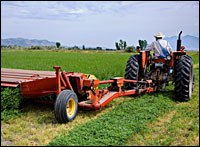
As debate over the 2007 Farm Bill heats up, more people than ever are realizing that the five-year omnibus legislation, due to expire this year, directly influences what crops are produced in this country, who gets paid for them and how much, the manner in which they are produced, what kind of product they become, and who eats what. They’re also connecting the dots and realizing that our current farm and food policy is making us overweight and unhealthy while lining the pockets of multinational corporations and polluting the environment.
Though the increased attention is exciting, the Farm Bill is a hugely complicated and can be difficult to get a handle on. Even its timeline is confusing and unpredictable. Is it too late to express opinions to representatives? The answer is no — but now is the time to get busy.
The hill’s two ag heavyweights — House Agriculture Committee Chairman Colin Peterson and his Senate counterpart, Tom Harkin — have made clear that their goal is to have a draft to the president before the 2002 Farm Bill expires at the end of September. With the Farm Bill, usually the House moves first — and we’re about to get a clear idea of what Peterson is thinking going into negotiations.
Chairman Peterson’s “mark” — his ideas for the Farm Bill that act as a starting point for discussion — will likely come out this week. Next week, the Subcommittee on Conservation (Title II), Credit (Title V), Energy (Title IX), and Research (Title VII) will decide on what issues to include within their own mark, and the rest of the subcommittees will begin this process after the Memorial Day recess.
After all the subcommittees outline what they’d like to see in the parts of the Farm Bill they’re responsible for, the full Agriculture Committee will come together to vote on the whole package, and this could happen as early as July. If they manage to stick to that timing, the Farm Bill would be ready for the House floor by late July, before Congress recesses for the entire month of August.
The Senate has a similar timeline, except that Chairman Harkin is not planning to release his mark until June. However, with fewer members the subcommittee process should not take quite as long, and Chairman Harkin would probably also like to have the bill voted on by the full Agriculture Committee and the Senate floor before the August recess. Then in September, selected legislators from both the House and Senate would come together to “conference” the bills, which invariably have lots of differences, and then both chambers must vote on the exact same version of the bill before it can be sent to the president’s desk.
Now, let’s have a reality check. In order for the timeline to actually take place as outlined, there would have to be very little disagreement about the ideas in the Farm Bill. However, all indications point to loads of divergence. Marker bills are pieces of legislation that are meant to express what a legislator thinks should be included in a larger piece of legislation, and the marker bills associated with the Farm Bill already show us that there are huge disparities in various legislators’ goals.
An example of one departure point is in the Nutrition Title. The Food Stamp Program provides money to low-income citizens and some legal immigrants to buy food. The recent attention to obesity as a national health issues has some organizations advocating for incentives to purchase healthy foods like fruits and vegetables, because these foods are typically more expensive and out of reach to low-income people. On the surface it’s hard to argue against more access to healthy food for everyone. However, policy changes that try to limit food choices for Food Stamp Program participants have historically been used by some legislators to cut benefits for the program, with the logic that if participants in the program are only allowed to buy certain kinds of food, they don’t need as much money. Both arguments have passionate sponsors, and a compromise might be difficult and time-consuming.
The discrepancies don’t end there, either. Peterson and Harkin have pledged to work closely, yet they also have publicly expressed opinions about their priorities in the Farm Bill that conflict. For example, Chairman Harkin has signaled that conservation and nutrition issues are his top priorities, while Chairman Peterson focuses much more on energy issues.
This timeline also assumes that there will not be a major challenge from the floor of either chamber. In the past, Agriculture Committees have held most of the decision-making power as to what goes into the Farm Bill. Once the bill is voted out of committee, there are rarely formidable challenges from the floor. However, in 2002 Rep. Ron Kind (D-WI, 3rd) introduced an amendment from the floor that would have shifted $19 billion from commodity payments to conservation — a significant departure from what the committee had proposed. The amendment was defeated 226-200, but it showed at the time that there was considerable support for change.
With the current level of public pressure to make major adjustments to the way farmers are paid and food is grown, I wouldn’t be completely surprised if there were one or more viable challenges to the Agriculture Committee’s proposal on the floor this time around. There are also other issues that could throw a wrench in the plan — payments for specialty crops, WTO compliance, the budget, and disaster relief, to name a few.
Which is to say that, while most of us advocates in D.C. and around the country are working under the assumption that the Farm Bill will pass by September 30, the likelihood of that happening is less than 100%. The last Farm Bill was passed 8 months after the 1996 Farm Bill expired, and this time around there seems to be more conflict.
That doesn’t mean, however, that we shouldn’t be weighing in right now with our legislators. The more people push for a fair and balanced Farm Bill today, the easier it will be to influence the outcome, to insure that the process is democratic, and that the law represents progress towards a just and equitable food and farming system.


